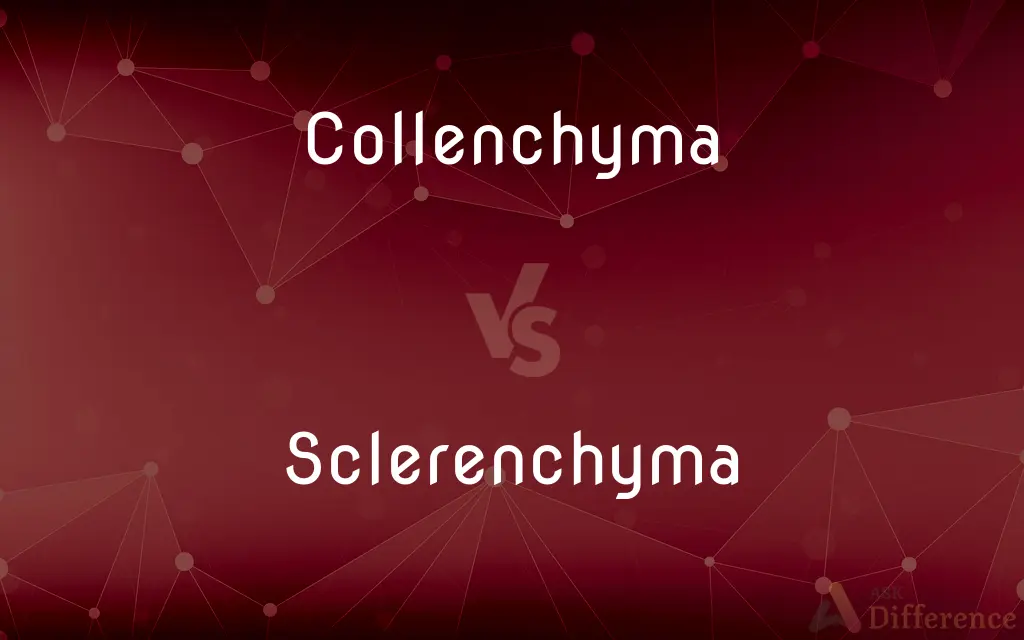Collenchyma vs. Sclerenchyma — What's the Difference?
Edited by Tayyaba Rehman — By Fiza Rafique — Updated on September 20, 2023
Collenchyma is a type of plant tissue that provides support and flexibility, while sclerenchyma is a rigid tissue that lends plants strength and support.

Difference Between Collenchyma and Sclerenchyma
Table of Contents
ADVERTISEMENT
Key Differences
In the realm of botany, understanding plant tissues is pivotal for grasping plant anatomy. Collenchyma, one of the three types of ground tissues, plays a crucial role in providing support and flexibility to plants, especially during their growing phases. The elongated cells of collenchyma typically have unevenly thickened cell walls made primarily of cellulose.
This contrasts with sclerenchyma, another essential ground tissue. Sclerenchyma is known for its thick, lignified walls and its role in providing rigidity, strength, and support to mature plants. Most sclerenchyma cells are dead at maturity, with their primary function being to fortify the plant structure.
The difference in wall composition between collenchyma and sclerenchyma cells is significant; while the former primarily comprises cellulose, the latter is reinforced with lignin, making it much more rigid. This is why young stems or petioles, which still require flexibility to grow, usually contain collenchyma, while mature, woody parts of a plant are abundant with sclerenchyma.
Comparison Chart
Primary Function
Provides support and flexibility
Provides strength and rigidity
Cell Wall Composition
Primarily cellulose
Lignified
ADVERTISEMENT
Cell Life Status
Typically alive at maturity
Typically dead at maturity
Location in Plants
Young stems, petioles, leaves
Mature, woody parts of plants; seeds
Cell Shape
Elongated with unevenly thickened walls
Thick-walled and regularly shaped; may be fiber-like
Compare with Definitions
Collenchyma
A plant tissue offering flexibility.
Young stems are rich in collenchyma, aiding their growth.
Sclerenchyma
Has two main types: fibers and sclereids.
The fibers in sclerenchyma contribute to the plant's tensile strength.
Collenchyma
Has walls primarily made of cellulose.
The cellulose composition of collenchyma cells allows them to be flexible.
Sclerenchyma
A plant tissue providing rigidity and support.
The sturdiness of mature plants is attributed to sclerenchyma.
Collenchyma
Prominent in parts of plants that are still growing.
You can find collenchyma in the expanding regions of the plant.
Sclerenchyma
Often found in mature, woody parts of plants.
The presence of sclerenchyma gives the tree its rigidity.
Collenchyma
Comprises cells with unevenly thickened walls.
The irregular walls of collenchyma cells give them a unique appearance.
Sclerenchyma
Contains cells with thick, lignified walls.
The strength of sclerenchyma comes from its lignin-rich walls.
Collenchyma
Plays a role in mechanical support.
Collenchyma provides the necessary support for plants in their growth phase.
Sclerenchyma
Cells are usually dead at maturity.
Sclerenchyma cells, despite being dead, play a vital role in plant support.
Collenchyma
A supportive tissue of plants, consisting of elongated living cells with unevenly thickened walls.
Sclerenchyma
A supportive plant tissue that consists of thick-walled, usually lignified cells. Sclerenchyma cells are either fibers or sclereids.
Collenchyma
(biology) A living, elongated, mechanical and flexible ground tissue with angular pectin depositions; present just under leaves, tendrils and stems of climbers; formed before vascular differentiation.
Sclerenchyma
(botany) A mechanical ground tissue, impermeable to water, which consists of cells having narrow lumen and thick, mineralized walls of lignin; present in stems, vascular bundles (of monocots), seed coverings, and vein and tips of leaves.
Collenchyma
A tissue of vegetable cells which are thickend at the angles and (usually) elongated.
Sclerenchyma
(zoology) The hard calcareous deposit in the tissues of the stony corals (Anthozoa).
Sclerenchyma
Vegetable tissue composed of short cells with thickened or hardened walls, as in nutshells and the gritty parts of a pear. See Sclerotic.
Sclerenchyma
The hard calcareous deposit in the tissues of Anthozoa, constituting the stony corals.
Common Curiosities
How do collenchyma cells appear under a microscope?
They appear elongated with unevenly thickened walls.
Are sclerenchyma cells hollow?
Due to their thick cell walls, the lumen or inner space is often reduced, making them appear less hollow.
In which plant parts is collenchyma commonly found?
Collenchyma is typically found in young stems, petioles, and leaves.
Do sclerenchyma cells play a role in seed protection?
Yes, sclerenchyma can be found around seeds, offering protection due to its hard nature.
Are sclerenchyma cells usually alive when they're mature?
No, sclerenchyma cells are typically dead at maturity.
What gives sclerenchyma its rigid nature?
Sclerenchyma's rigidity comes from its thick, lignified cell walls.
What is the primary function of collenchyma in plants?
Collenchyma provides support and flexibility to growing parts of plants.
What is the main component of collenchyma cell walls?
Collenchyma cell walls are primarily composed of cellulose.
Are there different types of sclerenchyma cells?
Yes, sclerenchyma consists of two main types: fibers and sclereids.
Can collenchyma cells divide?
Typically, mature collenchyma cells don't divide, but they can in some conditions.
Can collenchyma help plants withstand mechanical stresses?
Yes, its flexibility can help plants tolerate bending or twisting forces.
Why is collenchyma important for young plants or growing regions?
Collenchyma offers flexibility, allowing these regions to grow without constriction.
Which tissue type—collenchyma or sclerenchyma—is more associated with cellulose?
Collenchyma is more associated with cellulose, especially in its cell walls.
How do plants benefit from having sclerenchyma?
Sclerenchyma offers structural support and rigidity, especially in mature, woody regions.
Is lignin present in both collenchyma and sclerenchyma?
No, lignin is predominantly present in sclerenchyma, making it rigid.
Share Your Discovery

Previous Comparison
Asp vs. Saas
Next Comparison
Motherhood vs. FatherhoodAuthor Spotlight
Written by
Fiza RafiqueFiza Rafique is a skilled content writer at AskDifference.com, where she meticulously refines and enhances written pieces. Drawing from her vast editorial expertise, Fiza ensures clarity, accuracy, and precision in every article. Passionate about language, she continually seeks to elevate the quality of content for readers worldwide.
Edited by
Tayyaba RehmanTayyaba Rehman is a distinguished writer, currently serving as a primary contributor to askdifference.com. As a researcher in semantics and etymology, Tayyaba's passion for the complexity of languages and their distinctions has found a perfect home on the platform. Tayyaba delves into the intricacies of language, distinguishing between commonly confused words and phrases, thereby providing clarity for readers worldwide.















































